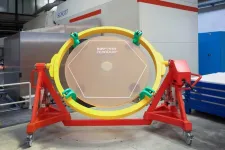(Press-News.org) Most coral reef restoration efforts involve restocking reefs with nursery-grown corals. However, if these corals are of the same stock as their wild counterparts, they will be equally vulnerable to the heat stress that caused the bleaching event in the first place. In a review publishing June 27 in the journal Trends in Microbiology, researchers discuss the potential of improving corals’ chances by inducing the evolution of heat tolerance in their symbionts—the mutualistic microbes that provide corals with nutrients in exchange for shelter and that are expelled during coral bleaching.
“Although heat-tolerant and -sensitive symbiont species occur in nature, even corals that harbor naturally tolerant symbionts have been observed to bleach during summer heatwaves,” write the authors, a team of marine scientists and bioengineers from Australia and New Zealand, including senior author Madeleine van Oppen (@spectacularia) of the Australian Institute of Marine Science and the University of Melbourne. “Experimental evolution of Symbiodiniaceae offers a means to shift their thermal tolerance limit upward, increasing host resistance to bleaching.”
To induce the evolution of heat-tolerance, researchers culture coral symbionts in the lab and expose successive generations to gradually increasing temperature, which maintains a selective pressure, so with each new generation, more heat-tolerant individuals are more likely to survive and reproduce.
“A critical decision about the efficacy of this intervention will revolve around determining whether field-deployed corals inoculated with heat-evolved symbionts exhibit greater tolerance to summer heatwaves compared with their native counterparts because all observations so far have been made in the lab,” they write.
Methods for culturing the symbionts will also need to be scaled up dramatically if this strategy is to be used at the necessary scale. “Research cultures are typically in the milliliter to liter volumes, yet thousands of liters would be required to inoculate millions of coral recruits reared from multiple reefs or regions,” the authors write.
The authors note that researchers may fine tune culture conditions for mass production of Symbiodiniaceae by taking inspiration from large-scale culturing of microalgae for biotechnological applications (while preventing yield loss). Experimental evolution of Symbiodiniaceae would be most effective in coral restoration efforts if used in conjunction with other measures, such as assisted gene flow, managed breeding of corals, and manipulation of coral-associated bacteria.
“All these interventions will be critical in maximizing the likelihood that coral reefs persist into the future, but it is imperative that these occur in tandem with significant emissions reductions and science-based reef management,” they write.
###
This research was supported by the Australian Research Council, the Paul G. Allen Family Foundation, and the Reef Restoration and Adaptation Program, and the Royal Society Te Apārangi.
Trends in Microbiology, Nitschke et al. “The use of experimentally evolved coral photosymbionts for reef restoration” https://www.cell.com/trends/microbiology/fulltext/S0966-842X(24)00139-2
Trends in Microbiology, (@TrendsMicrobiol) published by Cell Press, is a monthly review journal that provides a multidisciplinary forum for the discussion of all aspects of microbiology—from cell biology and immunology to genetics and evolution—and ranges across virology, bacteriology, protozoology, and mycology. Visit http://www.cell.com/trends/microbiology. To receive Cell Press media alerts, please contact press@cell.com.
END
About The Study: Rural residents with head and neck cancer experienced higher mortality rates and less annual improvement compared to urban counterparts in this cross-sectional study. Multilevel barriers may explain the widening rural-urban mortality gap, including alcohol and tobacco use and lower human papillomavirus (HPV) vaccination rates.
Corresponding Author: To contact the corresponding author, S. M. Qasim Hussaini, M.D.,M.S., email shussaini@uabmc.edu.
To access the embargoed study: Visit our For The Media website at this link https://media.jamanetwork.com/
(doi:10.1001/jamaoto.2024.1650)
Editor’s Note: Please see the article ...
About The Study: This study provides insights into complex factors surrounding maternal suicide, and it highlights opportunities for further research to understand long-term consequences of perinatal mental health. These findings also underscore the need for targeted evidence-based interventions and effective policies targeting mental health, substance use, and intimate partner problems to prevent maternal suicide and enhance maternal health outcomes.
Corresponding Author: To contact the corresponding author, Kara Zivin, Ph.D., M.S., M.A., M.F.A., email kzivin@umich.edu.
To access the embargoed study: Visit our For The Media website at this ...
In many cases of malignant melanoma, the effect of targeted treatment is lost over time. A research team from UZH and USZ has now discovered that a factor secreted by tumor cells is responsible for the resistance. These findings could pave the way for more effective therapies.
Malignant melanoma is one of the most aggressive types of cancer. Despite recent progress in effective therapies, the tumors of many patients are either resistant from the outset or become so during the course of treatment.
“It is therefore crucial to understand the mechanism ...
Researchers at Princeton and UCLA have developed a passive mechanism to cool buildings in the summer and warm them in the winter.
In an article published June 27 in the journal Cell Reports Physical Science, they report that by restricting radiant heat flows between buildings and their environment to specific wavelengths, coatings engineered from common materials can achieve energy savings and thermal comfort that goes beyond what traditional building envelopes can achieve.
“With the increase ...
HOUSTON ― Results from a new study led by researchers at The University of Texas MD Anderson Cancer Center support standard use of the more precise intensity-modulated radiotherapy (IMRT) over the alternative 3D-conformal radiotherapy (3D-CRT) for patients with unresectable, locally advanced non-small cell lung cancer (NSCLC). The study, published today in JAMA Oncology, revealed fewer side effects with IMRT, with similar survival outcomes.
A prospective secondary analysis of long-term outcomes from 483 patients on the Phase III NRG Oncology-RTOG 0617 randomized trial demonstrated ...
A study of multiple Mycena mushroom species reported in the journal Cell Genomics has found that they have unexpectedly large genomes. While the mushrooms had been thought to be purely saprotrophic – living by degrading dead organic material alone – the discovery suggests that they may instead have a collection of genes to enable them to adapt to different lifestyles as circumstances change. Interestingly, they show certain Mycena strains living in the Arctic have some of the largest mushroom genomes ever described.
These mushrooms show widespread growth across their genome. This includes not only the genes that help them invade or interact ...
In collaboration with the BioInnovation Institute (BII), AAAS is announcing the establishment of the BII & Science Translational Medicine Prize for Innovations in Women’s Health. Submissions are now open for the first year of the prize, which will be awarded in 2025.
The new award will aim to recognize and elevate scientists who have made outstanding research discoveries that have translational potential to impact women’s health around the world.
Relevant research topics include, but are not limited to, investigation into maternal health and gynecological conditions, areas of ...
Images
Simultaneously advancing biomaterials research with clinical applications and connecting researchers at well-resourced institutions with those rich in diverse talent is the aim of a $10.5 million center supported by the National Institutes of Health.
The Humanity Unlocking Biomaterials center, led by the University of Michigan and University of Washington, is designed to spur the development of biomaterials solutions that have potential in medical treatments by bringing together researchers and providing seed funding to kickstart ...
The European Southern Observatory’s Extremely Large Telescope (ESO’s ELT), under construction in the Chilean Atacama Desert, is one step closer to completion. German company SCHOTT has successfully cast the blank for the last of the 949 segments commissioned for the telescope’s primary mirror (M1). With a diameter of more than 39 metres, M1 will be by far the largest mirror ever made for a telescope.
Too large to be made from a single piece of glass, M1 will consist of 798 hexagonal segments, each about five centimetres thick and 1.5 ...
Older coastal cities, like Philadelphia, New York and Boston are at risk of being inundated by untreated sewage during floods. Due in part to the design of their combined sewer systems and in part due to sea level rise, these cities could be facing a growing public health crisis as climate change also drives more extreme precipitation, according to researchers at Drexel University who study urban stormwater management. The group recently published research that modeled the potential extent of the problem in a section of the coastal city of Camden, New Jersey, and the effectiveness of one proposed intervention to help ...



